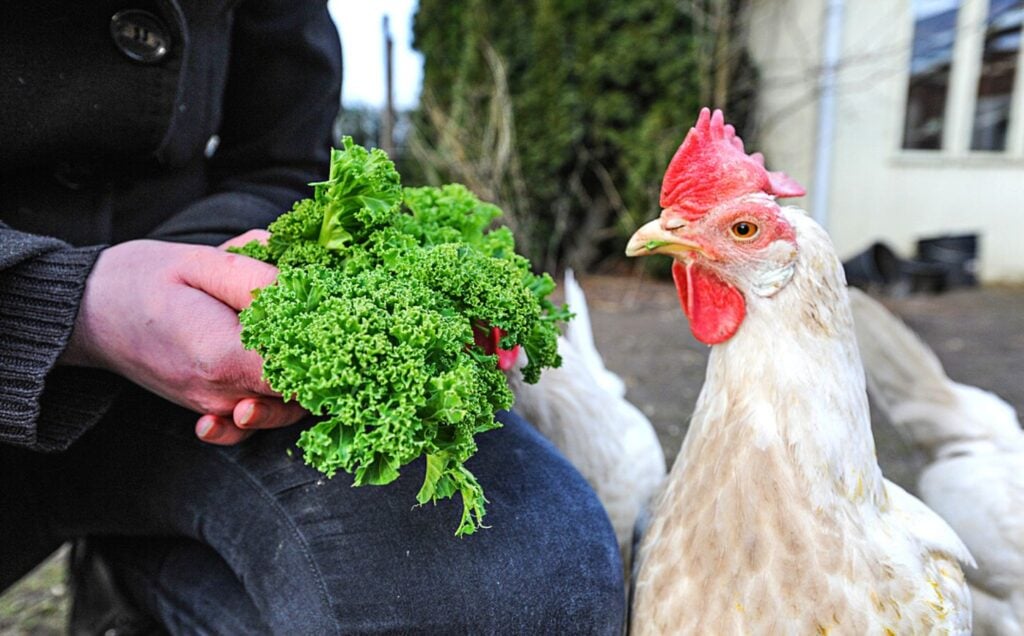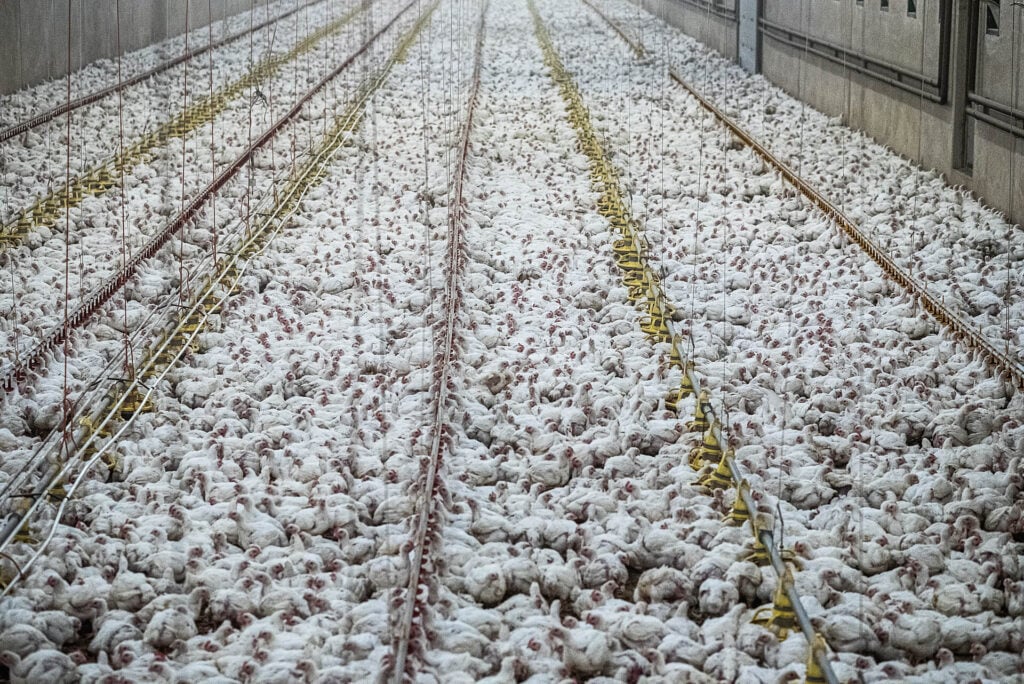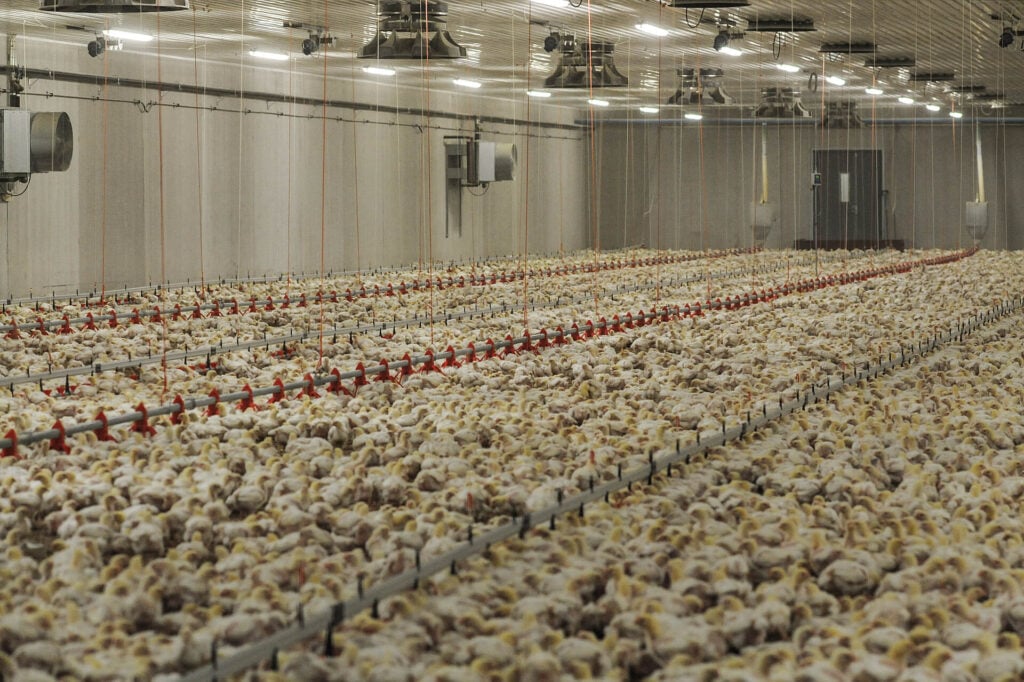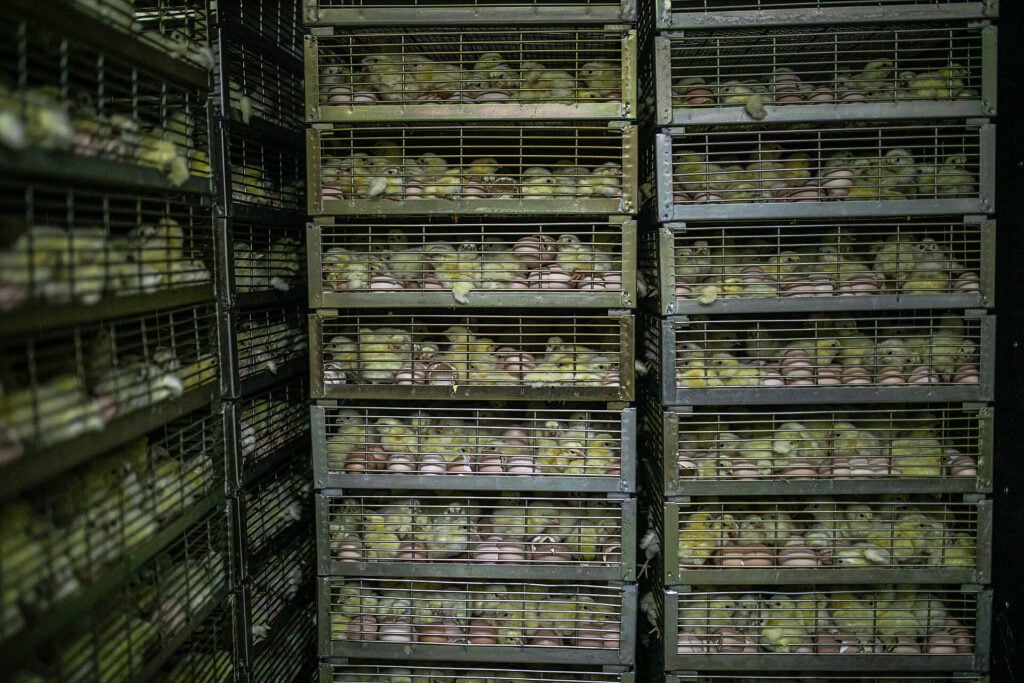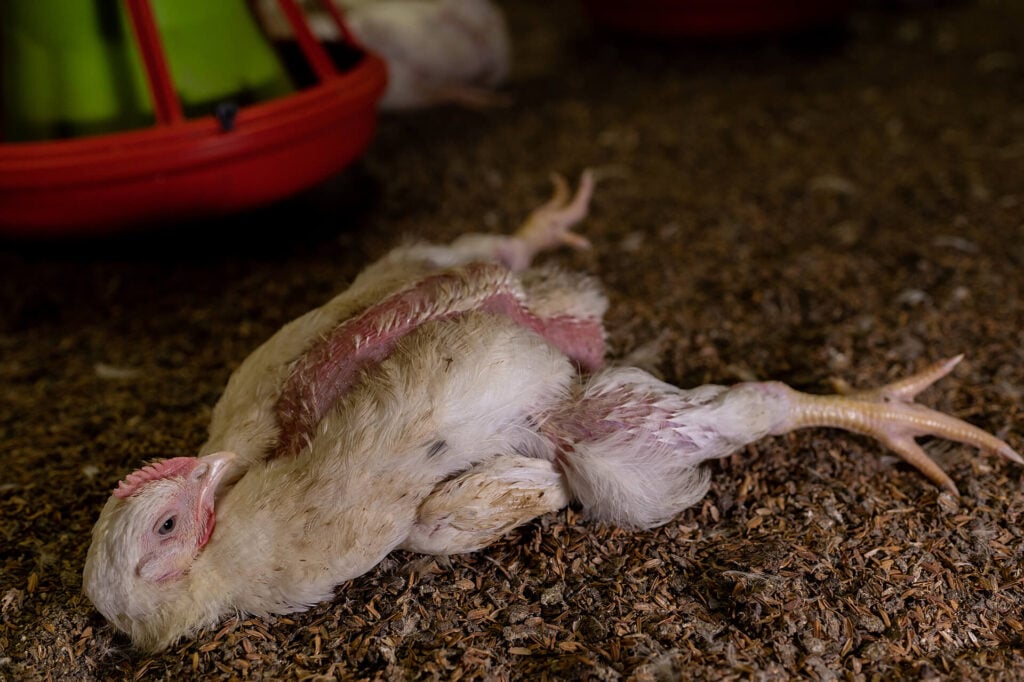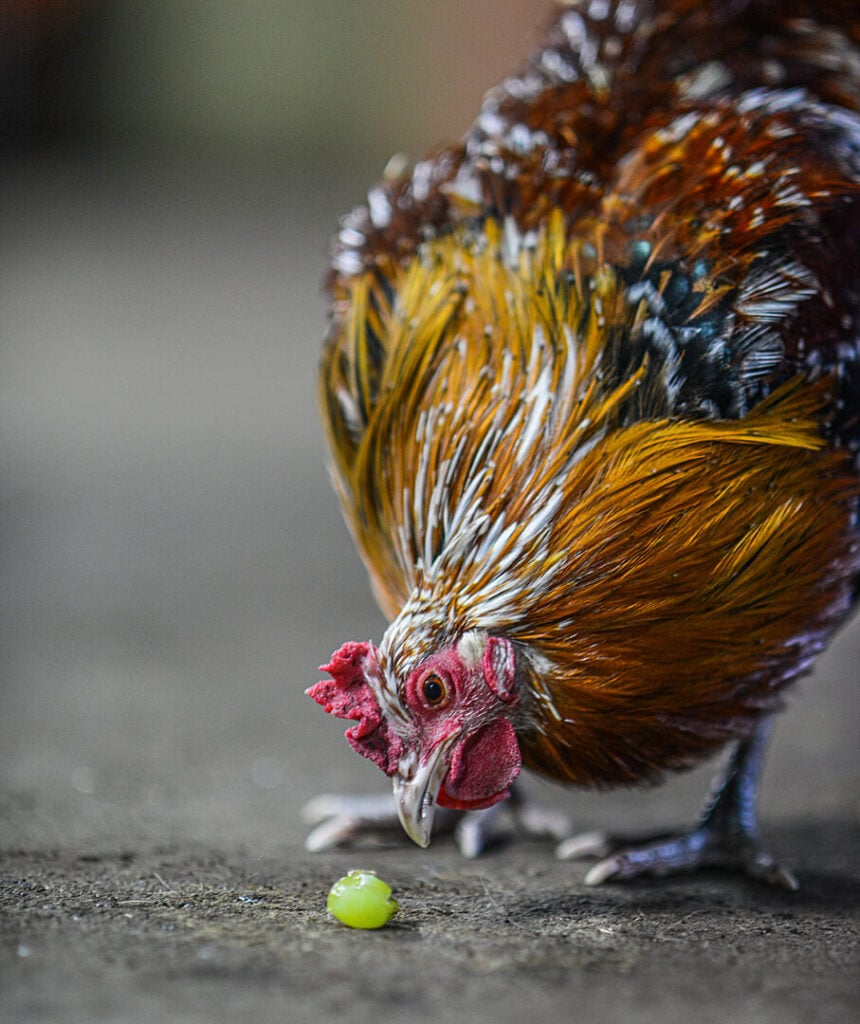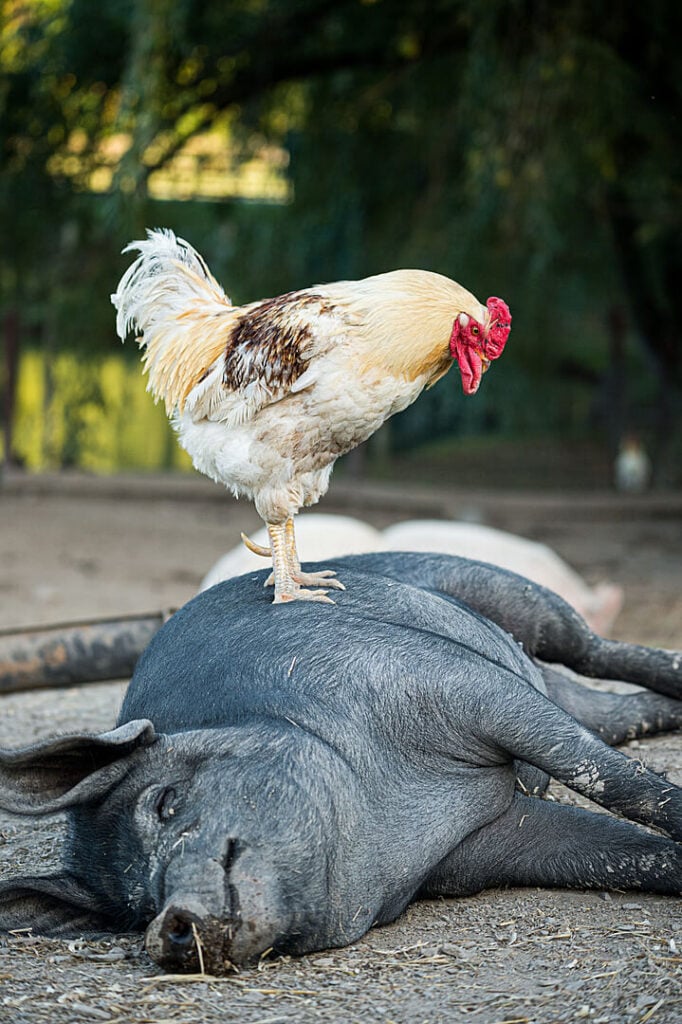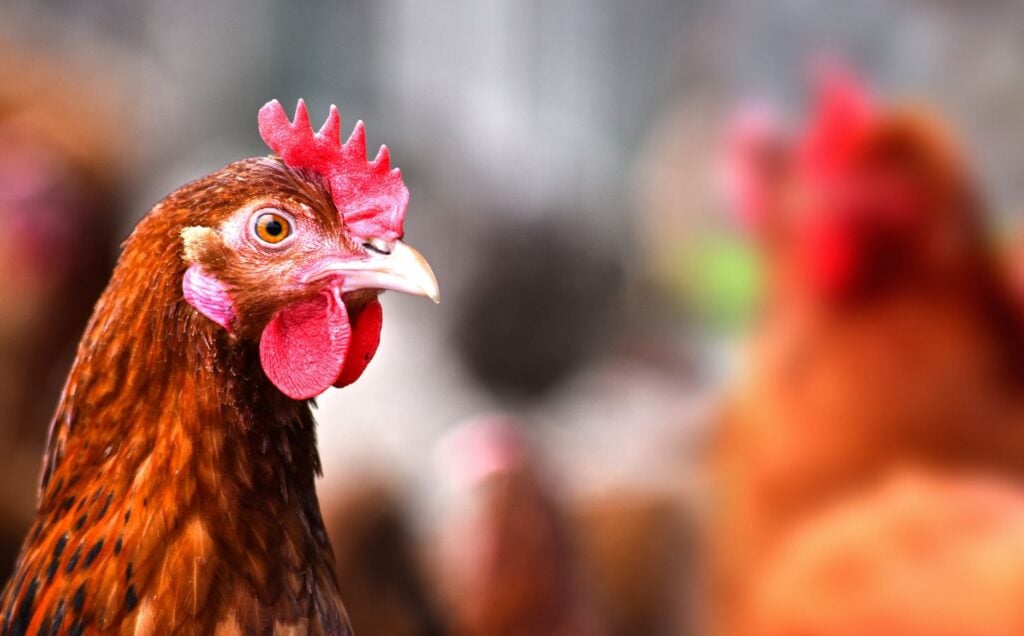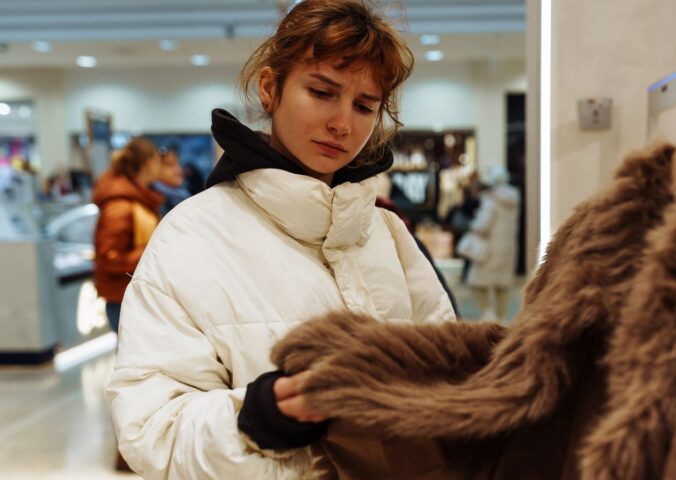Nutritious, sustainable, humane, harmless — chicken meat has received a lot of accolades over the last few decades. Many swear by it, with chicken widely considered a healthy source of protein, and a way to sidestep the high environmental cost of beef consumption.
It’s a nice concept. And one that has done wonders for the $352 billion global poultry industry.
But a growing body of research is highlighting the negative effects of eating chicken meat. From personal and public health concerns, pandemic risk, ethics and sentience, and a surprisingly high environmental impact, the more you look into it, the more proof you find: eating chickens is not only unnecessary, but damaging and cruel too.
With this in mind, here are six reasons, backed by scientific evidence, to rethink those chicken nuggets. And perhaps try a vegan alternative instead.
Jump to section:
- Reasons to take chicken off your plate
– Chicken as a ‘health food’
– Foodborne illness (food poisoning)
– Pandemic risk
– Animal welfare in the chicken industry
– Environmental impact
– Chickens are sentient - Vegan alternatives to chicken
- Chicken rescue charities
6 reasons to stop eating chicken
1. Chicken as a ‘health food’
Many people opt for chicken meat due to its high protein content and low fat levels (although the latter can vary depending on cooking methods and whether the animal’s skin is left on).
It’s often considered a more nutritious alternative to other meats. It’s well-documented that red and processed meats – including ham and sausages – may increase the risk of cancer (as recognized by the World Health Organization) and raise the risk of heart disease.
Concerns around cholesterol also remain a motivator for those swapping red meat for chicken, but the jury’s still out on whether it’s worth it.
A study funded by the National Institutes of Health (NIH), the primary medical research agency of the US government, found that both red and white meat increase cholesterol. The research was published in the peer-reviewed American Journal of Clinical Nutrition. Comparing beef, pork, chicken, and turkey with plant-based protein sources, researchers found that all animal meat varieties raised LDL (“bad”) cholesterol more than vegan protein – and, to a similar level.
Plant-based physician Dr. Michael Greger commented: “Switching from red meat to white meat likely wouldn’t make any difference [to cholesterol].
“And that’s really no surprise given how fat we’ve genetically modified chickens to be these days – up to 10 times more fat than they used to have a century ago,” he continued. “So there’s a number of cuts of beef that have less cholesterol-raising saturated fat than chicken.”
Take The Quiz!
Is chicken a carcinogen?
Some research has linked poultry with a higher risk of cancer, too. One study tested 100 grilled chicken samples from top restaurant chains in California, including McDonald’s, Burger King, and Applebee’s. All 100 samples contained PhIP, “a federally recognized carcinogen that has been linked to breast, prostate, and other cancers,” said the Physicians Committee for Responsible Medicine, which led the research.
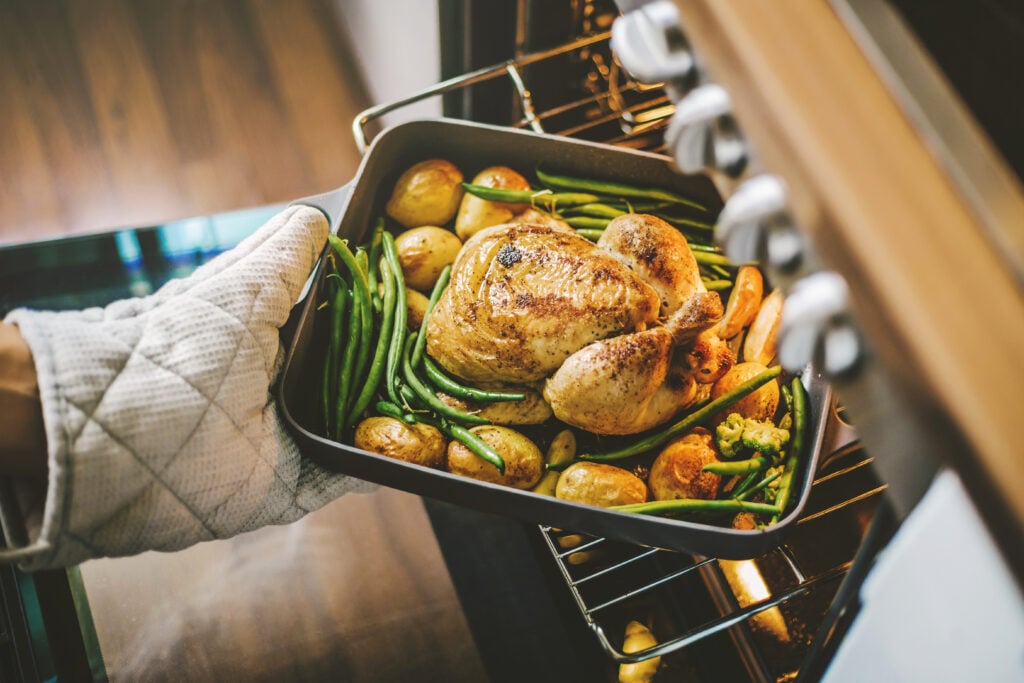
Back in 2019, another study sought to investigate the impact of meat-eating on cancer risk. Researchers looked at data from nearly half a million people in the UK, and found a connection between poultry and prostate cancer, as well as non-Hodgkin lymphoma (a cancer that starts in white blood cells). Separate research, which included more than 400,000 European participants, also found a possible link between poultry consumption and non-Hodgkin lymphoma. However, more research is needed in the field.
The relationship between chicken meat and cancer is still unclear. But one thing researchers and medical experts largely agree on is the protective properties of plant-based foods against cancer.
2. Foodborne illness (food poisoning)
Poultry is to blame for most cases of foodborne outbreaks, illnesses, and hospitalizations, US research says. In fact, from 1998 to 2012, poultry led to more foodborne disease outbreaks than any other food category. It also accounted for the second highest number of food poisoning-related deaths.
And this shouldn’t come as a surprise when you consider how much bacteria is found on chicken flesh. According to the Centers for Disease Control and Prevention (CDC), the national public health agency of the US, raw chicken is “often” contaminated with Campylobacter bacteria (which causes the most common bacterial diarrheal illness in the US), and “sometimes” contaminated with Salmonella and Clostridium perfringens bacteria, which affect the intestinal tract. (The FDA says about one in every 25 packages of chicken at the grocery store are contaminated with Salmonella.)
Along a similar vein, in 2013, Consumer Reports published a study that saw 300 chicken breasts from multiple meat producers tested for harmful bacteria. Ninety-seven percent of the samples contained potentially dangerous bacteria – including organic chicken brands.
“More than half of the samples contained fecal contaminants,” Consumer Reports added. “And about half of them harbored at least one bacterium that was resistant to three or more commonly prescribed antibiotics.”
3. Pandemic risk
Bird flu has been sweeping the globe, sparking headlines that warn of heightened pandemic risk. In 2022, avian flu led to the death of more than 52 million birds – a significant number of whom were chickens – in the US alone, making it the country’s deadliest bird flu outbreak to date.
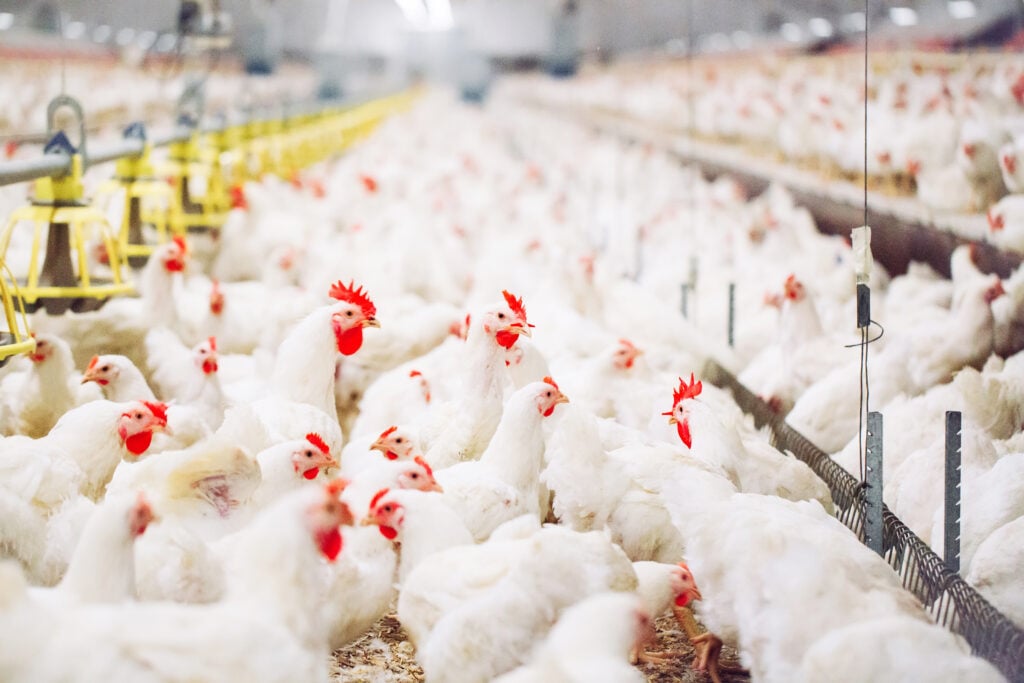
It’s a similar story in the UK, where mass preventative culling has taken the lives of millions of chickens and turkeys, as well as swans and captive zoo penguins.
Currently, bird flu infection is rare in humans, but not impossible. Since 2003, more than 860 humans have contracted it, and more than half died from the illness. As such, the CDC has named the highly pathogenic bird flu a pandemic risk. (Experts widely agree that you cannot contract bird flu from consuming fully cooked chicken; many of those who become infected with avian flu work closely with birds, such as on chicken or egg farms.)
On February 2, 2023, the Telegraph reported on the “unsettling news” that the H5N1 bird flu virus had spread to mammals, including otters and foxes, in the UK. And in late 2022, the virus spread to mink on a fur farm in Spain, with experts warning that “this is one of the scenarios from which a new pandemic could originate.”
4. Animal welfare in the chicken industry
More chickens are raised and killed for food than all other land animals combined. In Brazil, more than six billion chickens are slaughtered for meat every year. In the US, it’s approximately nine billion (with around 99 percent being raised in factory farms). Worldwide, the figure is close to 65 billion.
Almost all of the chickens we kill and eat are juveniles, usually reaching slaughter age at around 40 days old. This is due, in part, to intensive selective breeding. Nowadays, “frankenchickens” grow 400 percent faster than they did in the ’50s, leaving a significant number of farmed birds with heart, muscle, and bone diseases. Many struggle to hold their own weight up, and become unable to stand at all.
How are chickens treated in the meat industry?
After hatching, newborn chicks in the meat industry are stuffed into crates and placed on conveyor belts. The Humane League notes that throughout the process, they are treated like “inanimate objects” and are subject to various mutilations, sacrificing animal welfare in the name of profit. For example, in Europe (and many other parts of the world), it’s “commonplace” for chicks to have the tips of their beaks cut off, the British Hen Welfare Trust says, typically without pain relief. This is done to stop birds — who live in filthy, overcrowded conditions and as such, develop “unnatural behaviors” — from hurting one another. It’s not uncommon for them to resort to cannibalism, oftentimes due to severe stress.
In the US, there are little to no cruelty regulations in the chicken industry. In fact, no federal law — including the Animal Welfare Act or the Humane Methods of Slaughter Act — sets any welfare standards for birds raised for food.
This has left billions of animals without basic rights, and not just in the United States. Investigation after investigation finds chicken farms failing to provide their animals with adequate food, shelter, and enrichment. Instead, many chickens live in their own waste, alongside deceased or mutilated birds, under artificial lighting and controlled ventilation.
Sadly, even “free-range” chickens can live this way. In the UK’s meat industry, for example, chickens can be kept inside for 12 weeks before losing the “free-range” label. Yet as aforementioned, broiler chickens (those raised for meat) are typically killed before this, at around eight weeks.
Even those who survive long enough to reach slaughter age are not guaranteed to make it to the abattoir and onto a dinner plate. Last year, it was reported that in the US alone, 20 million chickens died while being transported to slaughterhouses. Hunger, dehydration, exhaustion, and trauma are often to blame, as well as heatstroke or extreme cold, depending on conditions.
How are broiler chickens killed?
Slaughter methods differ from country to country, but all could be considered barbaric. In the US and Canada, chickens are usually hung upside down and dragged through electrically charged water, intended to stun them, before their throats are cut with an industrial spinning blade.
They are then immersed in scalding water for feather removal. Oftentimes, they are fully conscious throughout the process. “Many are boiled alive,” the Humane League notes.
The same process is used in Brazil, Australia, and across Europe, alongside asphyxiation via gas.
5. Environmental impact
These days, it’s pretty well-documented that beef and dairy are two of the most environmentally destructive foods on the planet. This is due to a lot of factors, but chiefly emissions and deforestation (clearing land to rear cattle and grow the crops to feed them). So if chickens don’t emit as many greenhouse gases, and don’t require much land, why not bring on the KFC and call ourselves environmentalists?
The truth is, chicken is far from a sustainable choice when you consider what else is out there (see: the many, many eco-friendly plant foods available). In fact, the Center for Biological Diversity advises that lowering chicken consumption is a “powerful way that you can protect wildlife and the planet.” This is partly due to the industry’s “devastating” levels of pollution, the organizations says, which have “disastrous effects on water and soil quality.”
High amounts of chicken manure, and the mismanagement of such waste, contaminates waterways. This impacts drinking water and local wildlife, and can create aquatic dead zones, where little (if any) life can exist.
Like beef, chicken production also results in damaging greenhouse gas emissions – particularly nitrous oxide, which is more potent than methane. Additionally, over a 100-year timeframe, nitrous oxide has 298 times the global warming potential of CO2.
But the industry’s CO2 impact should not be ignored either: each year, America’s chicken sector produces the same CO2e emissions as more than 12 million cars, the Center for Biological Diversity highlights.
The charity adds that leaving just one chicken breast off your plate each week for a year saves 4,321 gallons of water, the equivalent to flushing a standard toilet 2,700 times.
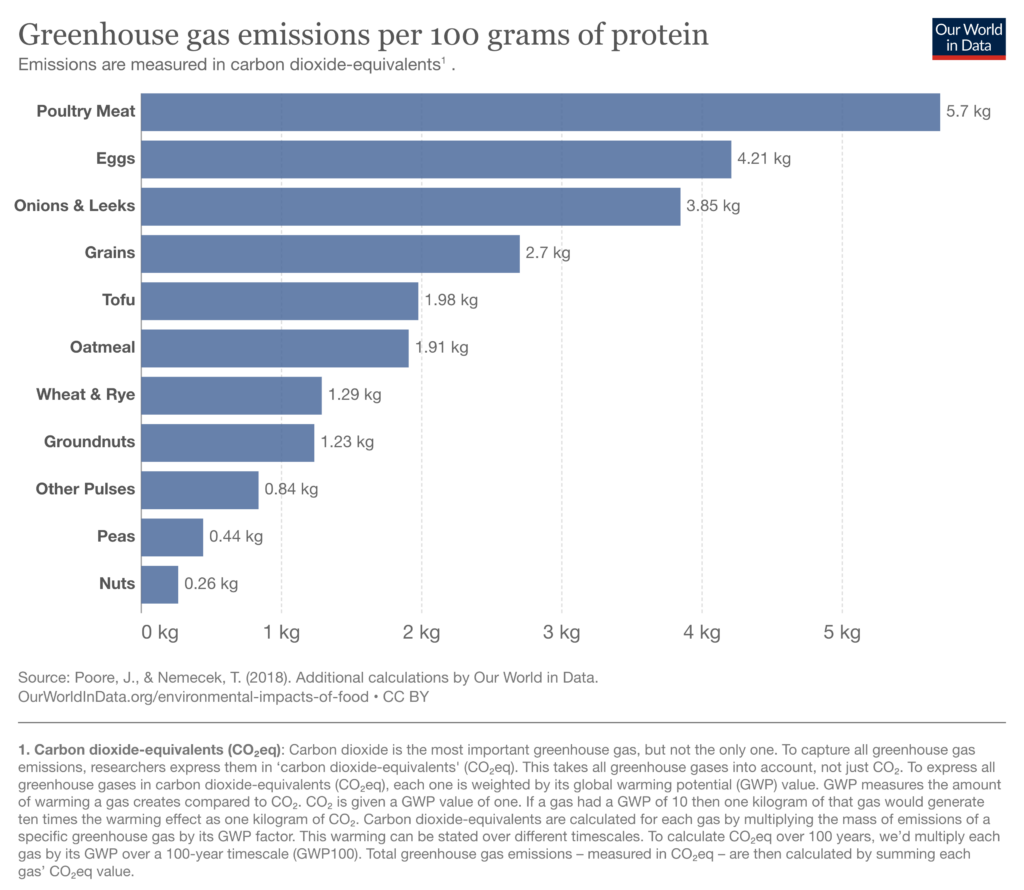
6. Chickens are sentient
It’s easy to underestimate the noble chicken. The meat and egg industries have done a wonderful job at marketing the species as nothing more than a commodity – free of personality, of individuality.
But chickens are far more cognitively sophisticated than we are led to believe – and those who spend time with them are quick to see that for themselves.
If you were to meet a chicken, they would likely remember you. This intelligent and inquisitive species can remember more than 100 different faces (including fellow chickens and humans), even after being estranged for an extended period of time.
Research has shown that chickens can not only recognize and identify their peers, as well as unfamiliar individuals, but use logical reasoning and inference to navigate social settings. Other studies have shown chickens can exhibit self-control, declining an immediate reward for a greater one later (researchers say this may indicate self-awareness and self-agency).
Chickens can experience empathy, solve puzzles, perceive intervals in time, and adopt the perspective of another individual. They dream (although we don’t yet know what they’re dreaming about) and display object permanence (comprehending that a recently hidden item still exists, which human babies only learn after a few months).
Chickens have their own social hierarchies and unique forms of language, communication, and expression. They create friendships (and rivalries), and show love and care for their young.
Lori Marino, a neuroscientist who specializes in animal behavior, published a report on chicken psychology back in 2017. Speaking to Mental Floss about it that same year, Marino said, “Chickens have a mind. They have a life.”
It’s a perspective that is rarely given the time of day, largely due to the repercussions of accepting it.
As Mental Floss reports: “People have a vested interest in thinking of farm animals as inanimate commodities, Marino says, because otherwise we’d start feeling bad about killing and eating them. Instead, we focus on turning them into better meat—a strategy that [Marino] believes dulls our scientific rigor and robs us of the chance to learn more about our fellow organisms.”
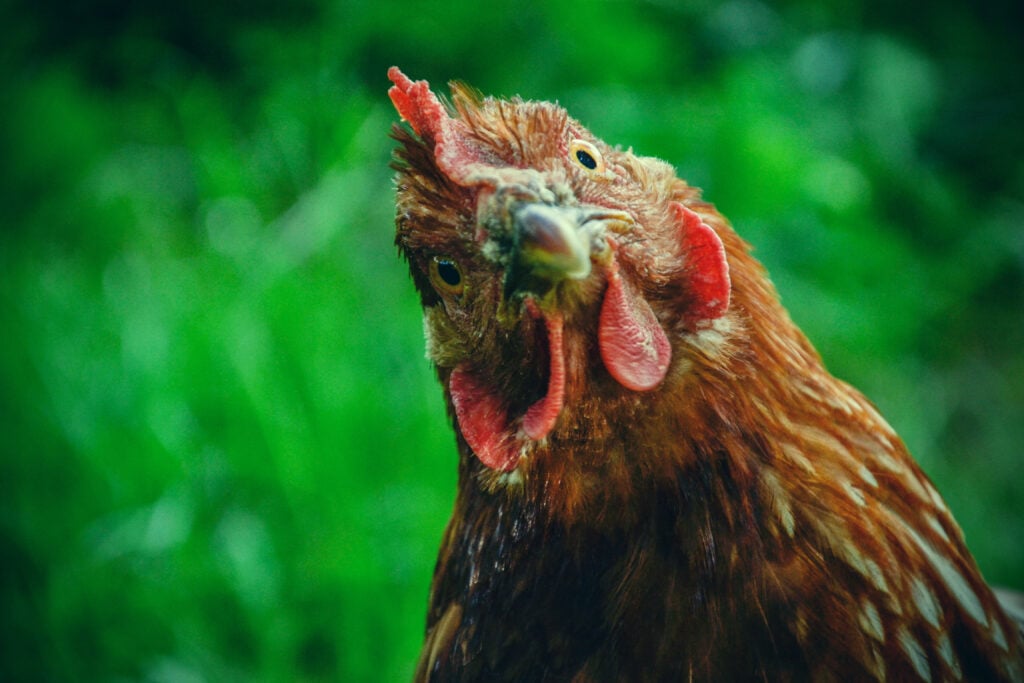
Vegan alternatives to chicken
Thankfully, there’s no need to eat chickens (or their eggs). There are a wealth of meat-free foods that provide all the nutrients we need to thrive, and deliver the same taste many associate with chicken meat. Whole, plant-based foods can be incredibly satisfying and healthful on their own, but if you’re looking for meat-free chicken products to try, keep an eye out for these vegan and vegan-friendly brands:
- Heura
- THIS
- VFC
- Alpha Foods
- Field Roast
- Linda McCartney
- Daring
- Lightlife
- Beyond Meat
- Quorn
- Morningstar Farms/Incogmeato
- Gardein
- SIMULATE
- Boca
- Tofurky
- Wicked Kitchen
- Vegie Delights
- Herb & Sons
- Greens & Goodness
- Deliciou
Chicken rescue charities
There are a number of organizations working overtime to rescue and rehome farmed chickens and other animals. Here are some groups and sanctuaries helping chickens that you can follow and support:
Chicken Run Rescue – Minnesota, US
Visit the nonprofit’s website here, Instagram here, or Facebook here.
Fresh Start for Hens – United Kingdom
Visit the group’s website, Facebook, or Instagram
Melbourne Chicken Rescue – Victoria, Australia
Visit the group’s Instagram or Facebook
NSW Hen Rescue – New South Wales, Australia
Visit the group’s website, Facebook, or Instagram
Happy Hen Animal Sanctuary – California, US
Visit the sanctuary’s website, Facebook, or Instagram
Sehati Animal Sanctuary – Indonesia
Visit the sanctuary’s website, Instagram, or YouTube
Crosskennan Lane Animal Sanctuary – Antrim, Northern Ireland
Read about the sanctuary’s Broiler Rescue Programme, or visit its Instagram, Facebook, or TikTok
Animal Place – California, US
Visit the sanctuary’s website, Facebook, Twitter, or Instagram
Pear Tree Farm Animal Sanctuary – Somerset, UK
Visit the sanctuary’s Facebook or Instagram
Guelph Humane Society – Ontario, Canada
Visit the charity’s Farm Animal Program page here, or its Instagram here
